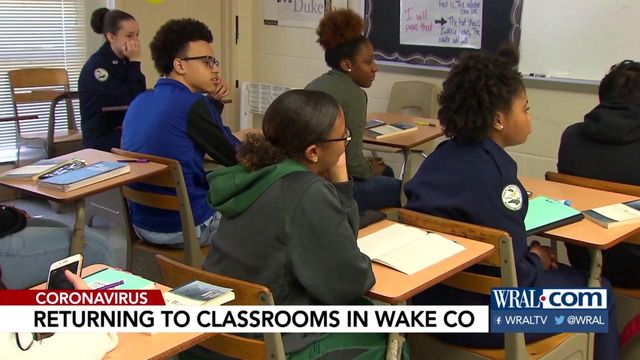Wake County schools weigh benefits, risks of opening in July
When North Carolina students return to schools, classrooms will look very different. Wake Schools is discussing when to reopen year round schools and how to keep students and staff safe.
The Wake County School District said it's looking at several possible scenarios for reopening, but a July start date is possible.
With 38,000 students enrolled in Wake County year-round schools, education experts and parents wonder about the challenges that lie ahead for them.
"If schools are to return to session, I think it’s safe to say they won’t look like it's looked in the past. It’ll look very different," said Kristen Stephens, Duke Associate Professor.
The idea doesn’t sit well with WCPSS parent Kira Kroboth, who said, "I feel like those of us going back in July are going to be the guinea pigs. I don’t want my kids to be the guinea pigs for this."
Kroboth said a later start date would give her and other parents peace of mind.
She said, "Push us back to the traditional calendar to give everything a little more time to shake out this summer, and see how things are going to play out."
Risk of returning to the classroom
About one third of the teaching force across the country is in the high risk category for COVID-19, according to a statistic shared by Stephens. She said it's important to consider the safety and health of the teachers.
Another major safety consideration is the ability of young children to understand social distancing or proper hand washing.
Katie Rosanbalm, Duke Research Scientist, said, "Social distancing isn’t something that small children are going to be able to do. They’re not going to understand it, they’re not going to get it."
Could teachers manage a classroom and worry about keeping young children safe from the spread of germs? Classrooms, especially for young children, are often breeding grounds for the spread of germs already.
On average, elementary school children get six to eight colds each school year, according to Johns Hopkins Medicine.
In an interview with CNN, first grade teacher Julie Miller said she is exposed to many germs on a daily basis, with children throwing up on her, sneezing on her and coughing on her.
Plus, said Rosanbalm, "They’re going to have to have recess. They’re going to have to move around. As much as you try to limit it, it’s going to be hard to do."
The risks of not opening schools soon
While many parents want schools to remain closed longer, some other parents are struggling to maintain their own jobs while keeping children at home. Likewise, some households lack resources for adequate online learning.
"We have teachers who live in locales who don’t have reliable internet and going and driving to their school parking lots and having class from the inside of their car so they access reliable internet," said Stephens.
Harris Cooper, Duke Professor of Psychology, is also concerned about the long term impact of online learning.
He points out that the pandemic could create a larger learning gap between kids of varying levels of achievement and home resources.
He said the resources in the home and the ability of each home to support online learning is dramatically different.
"The impact of the long summer break and even longer pandemic break is going to make even more dramatic the impact of the achievement gap based on ethnicity and social class," he said.
Harris also believes some things can be taught online, but there are some lessons kids really need to work on in person, alongside teachers and other children.
One poll showed parents of young children disproportionately reporting that they struggled balancing their work/daytime responsibilities and their child(ren)’s schooling--with 51% for kindergarteners and 46% for elementary schoolers, compared to 38% for all respondents.
These parents also disproportionately reported that they struggled keeping their children focused on schoolwork--with 62% for kindergarteners and 58% for elementary schoolers.
How will school look different when it opens?
School leaders have a lot to consider when reopening, such as changes to transportation, building design to keep people six feet apart, and scheduling.
Stephens suggested limiting the amount of students in a classroom, or providing a rotation schedule with students attending only on certain days.
"Like maybe I’m a Monday/Wednesday student, maybe I’m a Tuesday/Thursday student," said Stephens.
School leaders from Wake County Public Schools said they will follow health recommendations on state and local levels when students and staff make their way back.














